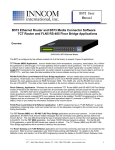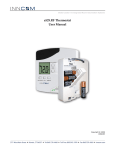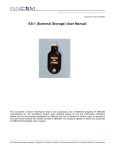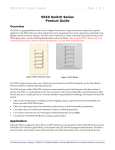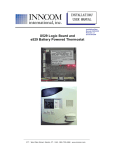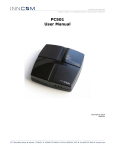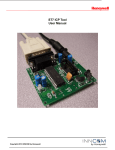Download FasBAC for INNCOM User Manual
Transcript
FasBAC for INNCOM User Manual Version 1.1 FasBAC for INNCOM User Manual Table of Contents 1. Introduction 3 2. CINET Configuration 5 3. Install 7 System Requirements 7 FasBAC Pre Install Configuration 7 FasBAC Install 7 FasBAC Room Auto Discovery 8 Uninstall 8 4. NAE Configuration 9 5. Starting and Stopping the FasBAC application 10 Start 10 Stop 10 6. FasBAC Configuration (FasBACCINET.csv) File 11 Structure of thefile 11 Creation by FasBAC (Room Auto Discovery Process) 11 Modifying the CSV file 12 7. Room monitoring and commanding 14 Monitoring Room points 14 Commanding Room points 14 8. Parameter Configuration 16 P5PT Communication Settings 16 Room AutoDiscovery Settings 17 BACnet Communication Settings 18 9. Log File / Troubleshooting 20 © 2005 Fastek International Ltd. Document Revision Date: March 27, 2008 2 FasBAC for INNCOM User Manual 1. Introduction FasBAC allows monitoring and control of room thermostats by creating a BACnet device for each one of them. Each BACnet device hosts a set of BACnet objects corresponding to the room thermostat points (as listed in Table 1). Table 1 Room Thermostat Point Mapping Room Data Point Rented Status BACnet Object name Rented Status BACnet BACnet Object Units Object Type BV "Not Rented", "Rented" X Occupancy Occupancy BV X BV "Not Occupied", "Occupied" "Off", "Do Not Disturb" BV "Off", "Make Up Room" X BV "Closed", "Open" X AV DEGREES_FAHRENHEIT X AV DEGREES_FAHRENHEIT X X (40 to 103) Do-notDisturb Make-uproom Window status Do not Disturb Make up room Balcony or Window Status Room Room Temperature Temperature Room Room Target Target Temperature Temperature Read Write (Range) X (0 or1) X AC-mode AC mode AV "Off,Fan Only,Fan Fixed,Auto" X X (1 to 4) Fan speed Fan speed MSV "Off,Low,Medium,High" X X (1 to 4) DEGREES_FAHRENHEIT X X (-50 to 150) Outside Air Outside Air AV Temperature Temperature * Note: * Outside Air Temperature BACnet object does not exist in all room BACnet devices, but is available in the virtual BACnet device having the name defined in the “Interface-BACnetDevice-Name” key in the FasBAC.ini file. © 2005 Fastek International Ltd. Document Revision Date: March 27, 2008 3 FasBAC for INNCOM User Manual BACnet is a standard communications protocol widely supported in the building automation system industry. FasBAC for INNCOM will interpret WinP5PT server activity and generate BACnet data that may be used by other BACnet client applications to control energy consumption according to room occupancy. Given the room occupied state, energy conservation strategies for unoccupied rooms can include: •Automatically lower the heating setpoint •Automatically raise the cooling setpoint • Turn off lights or other discretionary electrical loads • Enable security on doors and windows © 2005 Fastek International Ltd. Document Revision Date: March 27, 2008 4 FasBAC for INNCOM User Manual 2. CINET Configuration CIS5 software gets Room thermostat data from the CINET network. Configure CIS5 to connect to WinP5PT server. WinP5PT server can be configured to talk to the Riser Bridge or to B572 (acting as Riser or Floor Bridge) to get the Room thermostat data. FasBAC for CINET will also connect to WinP5PT server to monitor / command Room Thermostat points. The following are possible configurations of CINET network: B572 acting as Floor Bridge WinP5PT server connected over Ethernet with B572. B572 acting as Floor Bridge and connected to Room thermostats directly. B572 acting as Riser Bridge WinP5PT server connected over Ethernet with B572. B572 acting as Riser Bridge and connected to Room thermostats through Floor Bridge (use the roomdef.txt file for this configuration). Using Riser Bridge and Floor Bridge WinP5PT server connected over serial port to Riser Bridge. Riser Bridge connected to Floor Bridge and Floor Bridge connected to Room thermostats. The “Using Riser Bridge and Floor Bridge” configuration is illustrated in Figure 1 below. © 2005 Fastek International Ltd. Document Revision Date: March 27, 2008 5 FasBAC for INNCOM User Manual Figure 1. FasBAC for INNCOM installed on a CIS5 platform © 2005 Fastek International Ltd. Document Revision Date: March 27, 2008 6 FasBAC for INNCOM User Manual 3. Install System Requirements FasBAC for INNCOM runs as a Win32 service. Operating System As required by CIS5 server or ADS server. PC Memory: 512 MB Processor speed: 2 GHz Hard disk: 60GB WinP5PT Server The WinP5PT server can be installed on the same machine or remote machine on the same LAN. FasBAC Pre Install Configuration If the install media is a writeable floppy, then do the following changes in the FasBAC.ini file in the bin directory. If FasBAC.ini is not writable (on the install media) then after installation (next section) is complete, stop the FasBAC service and do the changes in it and then rerun the service • Configure the WinP5PTServerIPAddress and WinP5PTServerTCPPort to point to the WinP5PT server. • Do any other changes in the FasBAC.ini file as required (refer to the Parameter Configuration section). FasBAC Install To install FasBAC, launch setup.exe from the install package. Follow the instructions in the install program and complete the install. FasBAC Room Auto Discovery After successfully completing the install, check from the Event Viewer applet the messages confirming successful connection of FasBAC to WinP5PT server. If not then resolve the issue depending on the error messages. © 2005 Fastek International Ltd. Document Revision Date: March 27, 2008 7 FasBAC for INNCOM User Manual While service is running and successfully connected to WinP5PT server, wait for 20 minutes and then stop the service. During this time almost all the rooms will have reported themselves and will get listed in the FasBACCINET.csv file. Check room entries in the FasBACCINET.csv file and modify as required. Restart the service. Uninstall To uninstall FasBAC, go to the Windows Control Panel and run Add/Remove Programs. Select Fas-BAC for Energy, and click on Remove. Follow the instructions of uninstall program to complete removal. © 2005 Fastek International Ltd. Document Revision Date: March 27, 2008 8 FasBAC for INNCOM User Manual 4. NAE Configuration After completing the install action and commissioning of FasBAC for INNCOM, use Metasys Extended architecture user interface to auto discover the FasBAC for INNCOM BACnet devices (Rooms) and their BACnet objects (Room points). Map these objects into NAE’s to be able to build the control strategies. © 2005 Fastek International Ltd. Document Revision Date: March 27, 2008 9 FasBAC for INNCOM User Manual 5. Starting and Stopping the FasBAC application FasBAC runs as a Windows service. It starts automatically with the start of the operating system. (In case of a situation where the automatic start functionality needs to be disabled, set the ‘startup type’ property of the FasBAC service to ‘Manual’ using the Services control applet in Administrative Tools.) FasBAC can be started and stopped using the Windows Services Manager as described below: Start 1. Launch the Windows Control Panel. 2. Select Administrative Tools then select Services. 3. Right-click on the service named “FasBAC - CINET” and select Start. Stop 1. Launch the Windows Control Panel. 2. Select Administrative Tools then select Services. 3. Right-click on the service named “FasBAC - CINET” and select Stop. © 2005 Fastek International Ltd. Document Revision Date: March 27, 2008 10 FasBAC for INNCOM User Manual 6. FasBAC Configuration (FasBACCINET.csv) File Structure of file Each room is defined by a set of lines in the FasBACCINET.csv file. The first line in the set gives the room ID in CINET terms and the name of the name of the BACnet device object corresponding to the room. The rest of the lines give the name of the BACnet objects (one per line), corresponding to points in the room thermostat. Each set begins with a line of the following format: Format: CINET_Room_ID, Room_Name_Prefix + P5PT_Room_ID Example: 211,Room211 In the above example “Room” is the prefix and “211” is the room ID. The prefix “Room” can be changed using the “Room-BACnetDevice-NamePrefix” key in FasBAC.ini file. The rest of the lines in the set are in the following format: Format: , Room_Name_Prefix + CINET_Room_ID + “-” + Room_Thermostat_Point_Name Example: ,Room211-Rented Status In the above example “Rented Status” is a room thermostat point name. The point name list is listed in Table 1. To comment a line, prefix it with a double slash. Creation by FasBAC (Room Auto Discovery Process) FasBAC can create the FasBACCINET.csv file containing all the rooms and the selected room points. this reduces the manual effort required to create this file. Once FasBAC has created this file, it can be modified for individual rooms. To force FasBAC to create the FasBACCINET.csv file do the following steps: 1. Stop the service. 2. Delete the FasBACCINET.csv file (if one exists). 3. Make sure the key AutoDiscoveryEnabled in the FasBAC.ini file is set to 1. © 2005 Fastek International Ltd. Document Revision Date: March 27, 2008 11 FasBAC for INNCOM User Manual 4. Check the list of enabled room thermostat points listed in RoomThermostatPoint keys in the FasBAC.ini file. By default all room points listed in Table 1 are enabled. a. Those enabled will be listed as part of the room device set in the FasBACCINET.csv file. To disable a room thermostat point, place a semi-colon at beginning of the line in the FasBAC.ini file where the room thermostat point is listed. The disabled room point will not be added to any of the room sets created. 5. Start the service. 6. Let the service run for 20 minutes and then stop the service. 7. Stop the service and review the FasBACCINET.csv file. The FasBACCINET.csv file created will contain all the rooms which reported during this 20 minute period. Modifying the FasBACCINET.csv file The FasBACCINET.csv file can be changed in the following manner to accomplish addition/deletion of rooms and/or room thermostat points. After the changes are done in the FasBACCINET.csv file, their effect on the available BACnet objects is seen after the service is restarted. Note: Do not do any changes in the FasBACCINET.csv file while it is being populated by FasBAC itself during the “Room Auto Discovery Process”. Some of the changes that can be done are: • Add more rooms to the file by adding the appropriate set for each room. • Add more points to rooms. The point should be in the list described in Table 1. Follow the naming convention for the room point as described above in “Structure of file” section. Note: When adding a room point manually to the FasBACCINET.csv file it is not necessary to enable it in the FasBAC.ini file. • Comment out unwanted rooms or unwanted room thermostat points. If commenting out room, then remove the entire set. In situations where a similar modification (example: adding room point) needs to be done across all rooms then it might be efficient to delete the FasBACCINET.csv file and recreate the FasBACCINET.csv file using the “Room Auto Discovery Process”. © 2005 Fastek International Ltd. Document Revision Date: March 27, 2008 12 FasBAC for INNCOM User Manual 7. Room monitoring and commanding Monitoring Room points The room points can be monitored using the corresponding BACnet objects in FasBAC. For each room listed in the FasBACCINET.csv file, a virtual BACnet device is created. Also under each room device, BACnet objects for each room point listed under the room in the FasBACCINET.csv file are created. Refer to Table 1 to see the point list and its BACnet object type and units. After FasBAC connects to the WinP5PT Server, it will wait for “Process Image” (PI) from a room thermostat to arrive. Most of the rooms send a PI within 10 minutes. While FasBAC is waiting for the first PI, the objects are initialized with value ‘0’ and the reliability attribute is marked as unreliable. When the first PI from a room is received, all the BACnet objects belonging to the BACnet device object corresponding to the reporting room are updated. Also the reliability attribute is set to reliable. The BACnet room point object values get periodically updated as soon as FasBAC receives the next PI. FasBAC creates a BACnet object dedicated to monitoring its connection status to WinP5PT Server. The name of the BACnet object is “WinP5PT Server Link Status”. This BACnet object’s type is of type BV and object instance 1. The BACnet device name for this object is “CINET Interface” and the BACnet device instance is +1 value to the “OURINSTANCE” key in bacdoc.ini file. (If OURINSTANCE value is 65000, then device instance for “CINET Interface” BACnet device is 65001). Commanding Room points The room points can be commanded using the corresponding BACnet objects in FasBAC (or mapped into NAE). The room points which can be commanded are indicated in Table 1. To command the room point, change the value (within the range given in Table 1) of the corresponding BACnet object in FasBAC. If the room thermostat is online (reliable) FasBAC will immediately queue the command in its internal queue. Commands from the internal queue are sent to the room thermostat every 100ms (default). Except the command to change the rented status, all other commands get confirmation reply from WinP5PT Server. On receiving the success reply from WinP5PT Server, the command is removed from the FasBAC’s internal queue. © 2005 Fastek International Ltd. Document Revision Date: March 27, 2008 13 FasBAC for INNCOM User Manual If the room point is in offline (unreliable) state, then the command will not be sent to the room. In this case, the value of the BACnet object will stay at the commanded value until the room thermostat becomes online and sends the fresh value through the PI. If the command times out (30 seconds default) then FasBAC re-queue’s the command in its internal queue. If the command times out 3 times (default), it is removed from the queue and will not be sent again. In this case, the value of the BACnet room point object is updated to the value of the room point when a PI is received from the room. If on receiving a command, WinP5PT Server replies that the room does not exist, then the command is removed from the FasBAC’s internal queue and all the BACnet objects corresponding to the room thermostat are marked as unreliable. The value of the BACnet object will stay at the commanded value until the room thermostat becomes online and sends a PI. On receiving the PI from the room, the room point object values are updated and also the reliability attribute is marked as reliable. © 2005 Fastek International Ltd. Document Revision Date: March 27, 2008 14 FasBAC for INNCOM User Manual 8. Parameter Configuration P5PT Communication Settings Certain parameters used in P5PT communication can be modified as described in table 2. To change parameters listed in Table 2 do the following: 1. Stop the service 2. Open FasBAC.ini file (present in the Windows directory) from Windows Explorer. 3. Change the value of the key in the FasBAC.ini file as described in table 2. 4. Save FasBAC.ini.file and close it. 5. Restart the service Note: All changes to FasBAC configuration become effective after restarting FasBAC. Table 2. Configurable P5PT Communication Parameters Name Description IPAddress The IP address of the machine on which the WinP5PT Server software is running. The TCP Port on which WinP5PT Server software is listening for client connections. TCPPort LinkCheckTimeInSec CommandIntervalInMS CommandResponseTimeoutI nSec CommandMaxResend © 2005 Fastek International Ltd. Document Revision Date: March 27, 2008 Defines the period interval at which FasBAC will send the Link Beacon message to WinP5PT Server. Defines the period interval at which FasBAC will send from its internal queue the Room point command messages to WinP5PT Server. Defines the period for which FasBAC will wait for a response for a Room point command message from WinP5PT Server. Defines the maximum number of retries FasBAC will do after a timeout occurs for a Room point command Range Default Value 127.0.0.1 1024 – 49151 2002 (use the same value as defined in the .p5s script file) 60-3600 (seconds) 60 10-10000 (milliseco nds) 100 5-60 (seconds) 30 0-10 3 15 FasBAC for INNCOM User Manual message sent to WinP5PT Server. Room AutoDiscovery Settings The BACnet objects created during the Room Auto Discovery process for the Rooms can be controlled by following parameters in the FasBAC.ini file by following instructions to modify the file as described above. Table 3. Room Auto Discovery Parameters Name Description Range Default Value AutoDiscoveryEnabled To enable the Room Auto Discovery process if the FasBACCINET.csv does not exist. The name of the BACnet device used for hosting the WinP5PT server link status and Outside Temperature BACnet objects. Note: The name of the above two BACnet objects will be prefixed by this name. 1 or 0 1 Up to 24 characters “CINET Interface” Interface-BACnetDeviceName Room-BACnetDeviceNamePrefix Defines the name prefix for all BACnet devices created for each room. After the prefix the room CINET number is added (For room 211, the BACnet device name will be Room211) RoomThermostatPointX Nine keys exist in the ini file for this parameter. The key is obtained by replacing the X by the number. The value of each key will be the name of the room thermostat point from Table 1. To disable the point, place a semicolon at start of the key. The enabled keys will be used, when the auto discovery process is used to create the FasBACCINET.csv file. Up to 24 “Room” characters. Point names exactly as listed in table 1. BACnet Communication Settings FasBAC can host multiple BACnet devices. Two (fixed) BACnet devices are always created even though if no room thermostats are connected to FasBAC via WinP5PT server. Further for each room thermostat one (room) BACnet device is created. © 2005 Fastek International Ltd. Document Revision Date: March 27, 2008 16 FasBAC for INNCOM User Manual A BACnet device requires that several BACnet parameters be setup correctly in order to successfully communicate with other BACnet devices / software. Some of these settings must be unique for each BACnet device that resides on the same BACnet network. FasBAC’s BACnet communication is based on the parameters located in the BACDOC.INI and FasBAC.ini file. Both these files resides in the Windows directory. The name of each FasBAC BACnet device can be customized using the parameters described in Table 3 and 4. Further the BACnet Device ID used by each of these BACnet devices is in a serial order starting with that defined in ‘OurInstance’ key in Table 4. The device ID and device name of the first fixed BACnet device is defined by ‘OurInstance’ and ‘OurPeerName’ keys in table 4. This device does not contain any BACnet objects. The device name of second fixed BACnet device is defined by ‘InterfaceBACnetDevice-Name’ key in table 3. The device ID for this device is the number following the number defined in ‘OurInstance’ key in table 4. The device name of all room BACnet devices is as described in ‘RoomBACnetDevice-NamePrefix’ key in table 3. The device ID for these devices is the next number following the last one used for previous room BACnet device. To change parameters listed in Table 4 do the following: 1. Stop the service 2. Open BACDOC.INI file (present in the Windows directory) from Windows Explorer. 3. Change the value of the key in the BACDOC.INI file as described in table 4. 4. Save BACDOC.INI file and close it. 5. Restart the service Note: All changes become effective after restarting FasBAC. Table 4. Configurable BACnet Communication Parameters Name Description Range OurInstance The BACnet device ID. Must be unique for each BACnet device on the same BACnet network. If more than one FasBAC device is on the BACnet network, this value will have to be changed for each device. 1– 4,000,00 0 OurPeerName The BACnet device name. Must be unique for each FasBAC device on the same BACnet network. If more than one FasBAC device is on the BACnet network, this value will have up to 32 character s (case sensitive) © 2005 Fastek International Ltd. Document Revision Date: March 27, 2008 Default Value 65000 FasBACfor-CINET 17 FasBAC for INNCOM User Manual BACnetIPaddress BACnetIPsubnet BACnetIPport © 2005 Fastek International Ltd. Document Revision Date: March 27, 2008 to be changed for each device. The IP address of the network interface used with Fas-BAC. Note that the network interface should have a static IP address to avoid having to change this parameter. The subnet mask of the network interface used with Fas-BAC. The UDP port number to use for BACnet/IP (hex BAC0) This number must be the same for all BACnet devices that must communicate with one another. N/A N/A N/A N/A 1024 49151 47808 18 FasBAC for INNCOM User Manual 9. Log File / Troubleshooting FasBAC uses the Windows Application Event log for reporting errors and status messages. The message format follows Windows conventions for Windows event logging. To view the Log File, do the following steps: 1. From the Start Menu, open Control Panel. 2. From Control Panel, open Administrative Tools. 3. From Administrative Tools, open Component Services. 4. In Component Services, expand the Event Viewer and select Application. 5. In the right hand pane view messages with source column having value “FasBAC-forCINET”. To ensure latest log messages are available, do the following: 1. Right click on the Application (step 4 above) and select Properties. 2. In General tab in the Log size section, select the option ‘Override events as needed’. Event log messages will be generated for the following conditions: Normal Startup Events The following events should appear on FasBAC startup. Event Description Action to be taken Starting FasBAC service. None BACnet Initialized. None Connected to the WinP5PT server. If this message does not appear then check the IPAddress and TCPPort settings as described in table 3. P5PT error events Event Description Communications to the WinP5PT server has been lost. FasBAC will not send the following new value to the WinP5PT server as the room is offline: <room id – new value> FasBAC will not send the following new value to the WinP5PT server as it is out of range: <room id – new value> © 2005 Fastek International Ltd. Document Revision Date: March 27, 2008 Action to be taken Check if WinP5PT server is running. If FasBAC connects to WinP5PT server then check the connectivity of the machine. Check if the room thermostat is connected to the CINET network. Check the range of the given room thermostat point in table 1. 19 FasBAC for INNCOM User Manual FasBAC received following request indication from WinP5PT server: < room id – indication >. FasBAC failed to send the following command to < room id – command> Check if the room thermostat is connected to the CINET network Check if the room thermostat is connected to the CINET network. BACnet error events Event Description Failed to initialize the BACnet protocol handler. The service will be shutdown. BACnet communications reported the following Error: <> Action to be taken Check if the file bacdoc.dll is present in the same directory as FasBAC.exe. Please refer to table 5 to get more details on the error and resolve accordingly. Configuration File error events Event Description Error encountered on line number <linenumber> in the FasBACCINET.csv file. © 2005 Fastek International Ltd. Document Revision Date: March 27, 2008 Action to be taken Make the necessary changes in the FasBACCINET.csv file 20





















